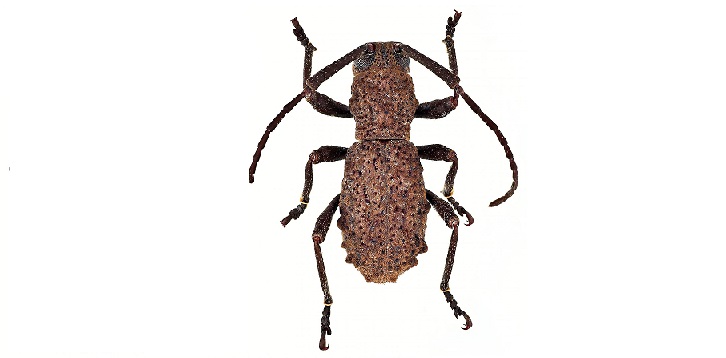The first long-horned beetle giving birth to live young discovered in Borneo
A remarkably high diversity of the wingless long-horned beetles in the mountains of northern Borneo is reported by three Czech researchers from the Palacký University, Olomouc, Czech Republic. Apart from the genera and species new to science, the entomologists report the first case of reproduction by live birth in this rarely collected group of beetles.
Generally, insects are oviparous, which means that their females lay eggs and the embryonic development occurs outside the female's body. On the other hand, ovoviviparous species retain their eggs in their genital tracts until the larvae are ready to hatch. Such mode of reproduction is a relatively rare phenomenon in insects and even rarer within beetles, where it has been reported for a few unrelated families only.
The long-horned beetles are a family, called Cerambycidae, comprising about 35,000 known species and forming one of the largest beetle groups.
"We studied the diversity of the rarely collected wingless long-horned beetles from Borneo, which is one of the major biodiversity hotspots in the world," says main author and PhD student Radim Gabriš. "The mountains of northern Borneo, in particular, host a large number of endemic organisms."
The scientists focused on the group which nobody had studied in detail for more than 60 years. They found surprisingly high morphological diversity in this lineage, which resulted in the descriptions of three genera and four species new to science.
"During a dissection of female genitalia in specimens belonging to the one of the newly described genera, named Borneostyrax, we found out that two females contained large larvae inside their bodies," recalls Radim Gabriš. "This phenomenon have been known in a few lineages of the related leaf beetles, but this is the first case for the long-horned beetles."
However, according to the authors, the modes of reproduction remain unknown for many beetle lineages besides Cerambycidae, so the ovoviviparity might be, in fact, much more common. Further detailed studies are needed for better understanding of the reproductive strategy in this group.
Source: Pensoft Publishers
BİOLOGY NEWS
-
RNA from Trained Aplysia Can Induce an Epigenetic Engram for Long-Term Sensitization in Untrained Aplysia.
-
HOW WE BECOME HAPPY
-
More tomatoes, faster: Accelerating tomato engineering
-
Purest yet liver-like cells generated from induced pluripotent stem cells
-
Legions of nanorobots target cancerous tumors with precision
-
CRISPR gene editing reveals new therapeutic approach for blood disorders
-
Quantum dots with impermeable shell: A powerful tool for nanoengineering
-
Thousands on one chip: New method to study proteins
-
Gene Drive Technology: Where is the future?
-
Four newly identified genes could improve rice
-
Watching the luminescent gene switch
-
DNA damage by ultrashort pulses of intense laser light
-
Mantis shrimp inspires next generation of ultra-strong materials
-
Specialized life forms abound at Arctic methane seeps
-
Ocean warming and acidification impact on calcareous phytoplankton



